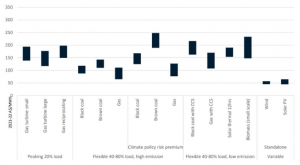New research has revealed that solar PV and wind continue to be the cheapest new-build electricity generation options in Australia, even when considering their additional integration costs such as energy storage and transmission.
The levelised cost of electricity (LCOE) for standalone solar PV in the country is currently AU$44 – 65/MWh (US$31.3 – 46.2/MWh), while for standalone wind it is AU$45 – 57/MWh, according to the annual GenCost report published by Australian national science agency CSIRO.
By comparison, the LCOE of a black coal generating plant is AU$87 – 118/MWh and gas generation AU$65 – 111/MWh.
While CSIRO’s cost projections for large-scale solar PV to 2050 have been “significantly revised downwards” compared to last year’s version of the report, this decline is paused in 2022-23 to reflect supply chains disruptions.
Projections for 2022-23 assume that cost reductions for all technologies will stall for 12 months as tight global supply chains will require more time to recover from the pandemic.
By 2030, the LCOE for standalone solar PV in Australia is forecasted to be in the range of AU$28 – 60/MWh and then continue its decline out to 2050, when it is expected to be AU$20 – 41/MWh, lower than any other generating technology.
 LCOE by technology and category in Australia for 2021. Source: CSIRO.
LCOE by technology and category in Australia for 2021. Source: CSIRO.
CSIRO expanded its results for 2030 to include a combined solar PV and wind category for different variable renewable energy (VRE) shares, with integration costs to support renewables estimated at AU$10 – $15/MWh depending on the VRE share.
From 2030, the estimates on additional integration costs associated with increasing solar and wind generation confirm that they are also competitive when transmission, synchronous condenser and storage costs are included, the report said.
The closest technology is the low range cost of a gas combined cycle generator, which can match the high range costs of variable renewables with integration costs. However, the low range 2030 gas combined cycle cost assumptions “will be challenging to achieve”, according to CSIRO.
A report published earlier this year from BloombergNEF (BNEF) found that the global average LCOE for utility-scale PV in the first half of 2021 was US$48/MWh, down 5% on the same period last year.
The research firm’s H1 2021 LCOE Update revealed that while it was already cheaper to build and operate solar PV projects over their lifetime than new coal- and gas-fired power plants for more than two-thirds of the world’s population, PV has passed a new milestone to become cheaper than existing coal plants in key markets such as China and India.





